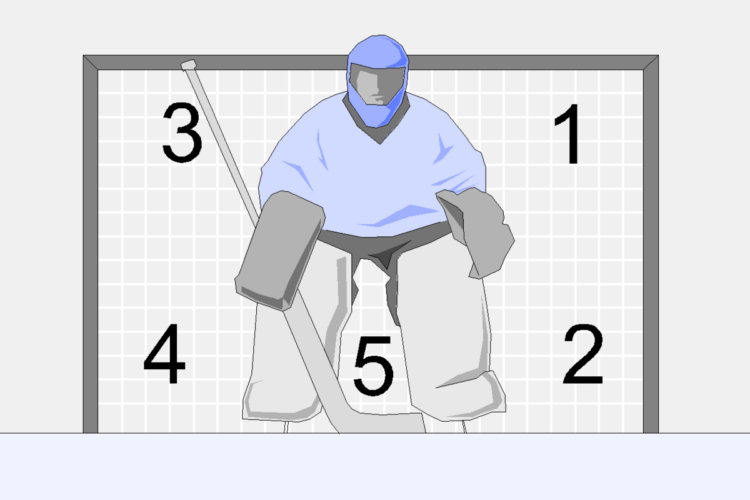
I. Introduction to Hockey Holes
II. What are Hockey Holes?
III. The Importance of Hockey Holes in Gameplay
IV. Different Types of Hockey Holes
A. The Five-Hole
B. The Six-Hole
C. The Seven-Hole
V. Strategies for Utilizing Hockey Holes in Offense
VI. Tips for Defending Against Hockey Holes
VII. Conclusion: The Role of Hockey Holes in Hockey Strategy
Hockey is a thrilling and fast-paced sport that requires a high level of skill, strategy, and teamwork. One important aspect of hockey that often goes unnoticed by casual observers is the concept of “hockey holes.” In this article, we will introduce you to hockey holes and help you understand why they are so crucial to the game.
So, what are hockey holes? Essentially, hockey holes refer to the spaces between a goaltender’s pads, gloves, and other equipment. These openings provide shooters with opportunities to score goals by placing the puck in these small gaps. Goaltenders must be constantly aware of these holes and work to minimize them, while shooters must be skilled at identifying and exploiting them.
Hockey holes play a vital role in the game of hockey, as they can be the difference between winning and losing. A team that is able to effectively utilize hockey holes in their offense can create scoring chances and put pressure on the opposing goaltender. On the other hand, a team that is able to effectively defend against hockey holes can prevent the other team from generating scoring opportunities and keep the puck out of their own net.
There are several different types of hockey holes that you should be aware of. The most well-known is the “five-hole,” which refers to the space between the goaltender’s legs. The five-hole is a popular target for shooters, as it can be difficult for goaltenders to cover effectively. Other hockey holes include the “six-hole,” which is the space between the goaltender’s arm and body, and the “seven-hole,” which is the space between the goaltender’s glove and body.
Now that you have a better understanding of what hockey holes are and why they are important, let’s talk about some strategies for utilizing them in your offense. One key strategy is to practice your shooting accuracy and placement. By working on your ability to place the puck in specific locations, you can take advantage of hockey holes and increase your chances of scoring. Additionally, it can be helpful to study the tendencies of opposing goaltenders and look for patterns in their movements and positioning. By identifying areas where the goaltender is vulnerable, you can create scoring opportunities and put pressure on the other team.
Defending against hockey holes is also an important aspect of the game. To do this effectively, goaltenders must be aware of their positioning and the placement of their equipment at all times. They must also be able to read the movements of shooters and react quickly to cover any openings that may arise. Additionally, defensemen can help by blocking shots and disrupting the other team’s offensive schemes, making it more difficult for shooters to find and exploit hockey holes.
In conclusion, hockey holes play a critical role in the game of hockey. By understanding what hockey holes are and how to utilize them in your offense, you can create scoring chances and put pressure on the opposing goaltender. On the other hand, by defending against hockey holes effectively, you can prevent the other team from generating scoring opportunities and keep the puck out of your own net. Whether you are a player, coach, or fan, it is important to be aware of hockey holes and the impact they can have on the outcome of a game.
Introduction to Hockey Holes
Hockey is a thrilling and fast-paced sport that requires a high level of skill, strategy, and teamwork. One important aspect of hockey that often goes unnoticed by casual observers is the concept of “hockey holes.” In this article, we will introduce you to hockey holes and help you understand why they are so crucial to the game.
What are hockey holes?
Essentially, hockey holes refer to the spaces between a goaltender’s pads, gloves, and other equipment. These openings provide shooters with opportunities to score goals by placing the puck in these small gaps. Goaltenders must be constantly aware of these holes and work to minimize them, while shooters must be skilled at identifying and exploiting them.
The importance of hockey holes in gameplay
Hockey holes play a vital role in the game of hockey, as they can be the difference between winning and losing. A team that is able to effectively utilize hockey holes in their offense can create scoring chances and put pressure on the opposing goaltender. On the other hand, a team that is able to effectively defend against hockey holes can prevent the other team from generating scoring opportunities and keep the puck out of their own net.
Different types of hockey holes
There are several different types of hockey holes that you should be aware of. The most well-known is the “five-hole,” which refers to the space between the goaltender’s legs. The five-hole is a popular target for shooters, as it can be difficult for goaltenders to cover effectively. Other hockey holes include the “six-hole,” which is the space between the goaltender’s arm and body, and the “seven-hole,” which is the space between the goaltender’s glove and body.
Strategies for utilizing hockey holes in offense
One key strategy for utilizing hockey holes in your offense is to practice your shooting accuracy and placement. By working on your ability to place the puck in specific locations, you can take advantage of hockey holes and increase your chances of scoring. Additionally, it can be helpful to study the tendencies of opposing goaltenders and look for patterns in their movements and positioning. By identifying areas where the goaltender is vulnerable, you can create scoring opportunities and put pressure on the other team.
Tips for defending against hockey holes
Defending against hockey holes is also an important aspect of the game. To do this effectively, goaltenders must be aware of their positioning and the placement of their equipment at all times. They must also be able to read the movements of shooters and react quickly to cover any openings that may arise. Additionally, defensemen can help by blocking shots and disrupting the other team’s offensive schemes, making it more difficult for shooters to find and exploit hockey holes.
Conclusion: The role of hockey holes in hockey strategy
In conclusion, hockey holes play a critical role in the game of hockey. By understanding what hockey holes are and how to utilize them in your offense, you can create scoring chances and put pressure on the opposing goaltender. On the other hand, by defending against hockey holes effectively, you can prevent the other team from generating scoring opportunities and keep the puck out of your own net. Whether you are a player, coach, or fan, it is important to be aware of hockey holes and the impact they can have on the outcome of a game.
II. What are Hockey Holes?
If you’re new to the world of hockey, you might be wondering, “What are hockey holes?” Well, wonder no more! Hockey holes refer to the spaces between a goaltender’s pads, stick, and body that shooters aim for when taking a shot on goal. These holes are constantly moving and changing, making them a challenging but exciting aspect of the game.
There are three main hockey holes that you should know about: the five-hole, the six-hole, and the seven-hole. Let’s break them down:
**A. The Five-Hole**
The five-hole is the most well-known of the hockey holes. It’s the space between the goalie’s legs, and it’s called the “five-hole” because there are technically five “parts” to it: the two skates, the two pads, and the goalie’s stick. Shooting for the five-hole is a popular strategy because it’s a relatively large target, but it’s also one of the most difficult to hit because the goalie can easily close it off with their legs or pads.
**B. The Six-Hole**
The six-hole is the space between the goalie’s arm and their body. It’s called the “six-hole” because it’s the sixth potential target on the goalie (if you count the five parts of the five-hole as one target). This hole is a bit smaller than the five-hole, but it can be a great target if the goalie is positioned too far to one side or the other.
**C. The Seven-Hole**
The seven-hole is the space between the goalie’s glove and their body. It’s called the “seven-hole” because it’s the seventh potential target on the goalie. This hole is often the smallest of the three, but it can be a great target if the goalie is reaching for a shot with their glove.
It’s worth noting that hockey holes are not static targets. They are constantly moving and changing as the goalie moves and adjusts their position. This means that shooters need to be quick, agile, and skilled in order to hit the right hole at the right time.
In addition, hockey holes are not just important for shooters. Defenders need to be aware of them as well, since they can be used to create passing lanes and scoring opportunities. By understanding hockey holes and how to defend against them, players can improve their game and become more effective on the ice.
So, whether you’re a seasoned hockey veteran or a brand-new fan, hockey holes are an essential part of the game. By learning more about them and how to utilize them, you can become a more informed and engaged fan, and maybe even improve your own skills on the ice!
II. What are Hockey Holes?
If you’re new to the world of hockey, you might be wondering, “What are hockey holes?” Well, wonder no more! Hockey holes refer to the spaces between a goaltender’s pads, stick, and body that shooters aim for when taking a shot on goal. These holes are constantly moving and changing, making them a challenging but exciting aspect of the game.
A. The Five-Hole
The five-hole is the most well-known of the hockey holes. It’s the space between the goalie’s legs, and it’s called the “five-hole” because there are technically five “parts” to it: the two skates, the two pads, and the goalie’s stick. Shooting for the five-hole is a popular strategy because it’s a relatively large target, but it’s also one of the most difficult to hit because the goalie can easily close it off with their legs or pads.
B. The Six-Hole
The six-hole is the space between the goalie’s arm and their body. It’s called the “six-hole” because it’s the sixth potential target on the goalie (if you count the five parts of the five-hole as one target). This hole is a bit smaller than the five-hole, but it can be a great target if the goalie is positioned too far to one side or the other.
C. The Seven-Hole
The seven-hole is the space between the goalie’s glove and their body. It’s called the “seven-hole” because it’s the seventh potential target on the goalie. This hole is often the smallest of the three, but it can be a great target if the goalie is reaching for a shot with their glove.
It’s worth noting that hockey holes are not static targets. They are constantly moving and changing as the goalie moves and adjusts their position. This means that shooters need to be quick, agile, and skilled in order to hit the right hole at the right time.
In addition, hockey holes are not just important for shooters. Defenders need to be aware of them as well, since they can be used to create passing lanes and scoring opportunities. By understanding hockey holes and how to defend against them, players can improve their game and become more effective on the ice.
So, whether you’re a seasoned hockey veteran or a brand-new fan, hockey holes are an essential part of the game. By learning more about them and how to utilize them, you can become a more informed and engaged fan, and maybe even improve your own skills on the ice!
III. The Importance of Hockey Holes in Gameplay
If you’re new to the world of hockey, you might be wondering – what exactly are hockey holes? Well, in the game of hockey, hockey holes refer to the spaces between a goaltender’s pads, skates, and gloves that a shooter can aim for to score a goal. These openings provide opportunities for offensive players to capitalize on and score points, making them a crucial aspect of the game.
But why are hockey holes so important in gameplay? Here are a few reasons:
1. **Goal-scoring opportunities**: Hockey holes offer offensive players valuable goal-scoring opportunities. By aiming for these openings, players can increase their chances of getting the puck past the goalie and into the net.
2. **Forcing the goalie to move**: When a shooter aims for a hockey hole, it forces the goaltender to move and adjust their position, potentially leaving other openings exposed. This movement can create even more opportunities for the offensive team to score.
3. **Distracting the defense**: Hockey holes can also serve as a distraction for the defensive team. As the shooter aims for a specific opening, the defense may focus too much on that area and neglect other potential threats, leaving the offensive team with an advantage.
Now that we understand the importance of hockey holes let’s take a look at the different types of openings that exist:
**A. The Five-Hole**
The five-hole is the space between a goaltender’s legs, and it is perhaps the most well-known hockey hole. This opening can be incredibly difficult for a goalie to defend, especially if the shooter has a quick release or is able to catch the goaltender off guard.
**B. The Six-Hole**
The six-hole refers to the space between the goalie’s arm and their body. This opening can occur when the goaltender has their arm extended to block a shot, leaving the rest of their torso exposed.
**C. The Seven-Hole**
The seven-hole is the space between the goaltender’s glove and their body. This can occur when the goalie has their glove raised to block a shot, leaving the rest of their body vulnerable.
As an offensive player, it’s essential to be aware of these different types of hockey holes and how to exploit them. Here are a few strategies to consider:
* **Practice your accuracy**: The more accurate your shots are, the better your chances of finding an opening. Practice shooting at specific targets to improve your accuracy.
* **Use deception**: By faking shots or passing, you can throw off the goalie’s positioning and create new opportunities for yourself.
* **Look for movement**: If you see the goalie moving to block a shot, try to anticipate where they’ll be and aim for the opening that will be created.
On the defensive side, it’s crucial to be aware of these same openings and how to protect them:
* **Stay in position**: Keep your body and equipment aligned to minimize the openings between them.
* **Anticipate the shooter’s moves**: By watching the shooter’s body language and movements, you can predict where they’ll aim and adjust your position accordingly.
* **Communicate with your teammates**: Work together to cover all of the potential openings and prevent the offensive team from finding a weak spot.
In conclusion, hockey holes play a vital role in the game of hockey, providing valuable goal-scoring opportunities and shaping the strategies of both offensive and defensive teams. By understanding these openings and how to utilize them, you can elevate your gameplay and contribute to your team’s success.
The Importance of Hockey Holes in Gameplay
If you’re new to the world of hockey, you might be wondering – what exactly are hockey holes? Well, in the game of hockey, hockey holes refer to the spaces between a goaltender’s pads, skates, and gloves that a shooter can aim for to score a goal. These openings provide opportunities for offensive players to capitalize on and score points, making them a crucial aspect of the game.
But why are hockey holes so important in gameplay? Here are a few reasons:
- Goal-scoring opportunities: Hockey holes offer offensive players valuable goal-scoring opportunities. By aiming for these openings, players can increase their chances of getting the puck past the goalie and into the net.
- Forcing the goalie to move: When a shooter aims for a hockey hole, it forces the goaltender to move and adjust their position, potentially leaving other openings exposed. This movement can create even more opportunities for the offensive team to score.
- Distracting the defense: Hockey holes can also serve as a distraction for the defensive team. As the shooter aims for a specific opening, the defense may focus too much on that area and neglect other potential threats, leaving the offensive team with an advantage.
Different Types of Hockey Holes
Now that we understand the importance of hockey holes let’s take a look at the different types of openings that exist:
A. The Five-Hole
The five-hole is the space between a goaltender’s legs, and it is perhaps the most well-known hockey hole. This opening can be incredibly difficult for a goalie to defend, especially if the shooter has a quick release or is able to catch the goaltender off guard.
B. The Six-Hole
The six-hole refers to the space between the goalie’s arm and their body. This opening can occur when the goaltender has their arm extended to block a shot, leaving the rest of their torso exposed.
C. The Seven-Hole
The seven-hole is the space between the goaltender’s glove and their body. This can occur when the goalie has their glove raised to block a shot, leaving the rest of their body vulnerable.
Strategies for Utilizing Hockey Holes in Offense
As an offensive player, it’s essential to be aware of these different types of hockey holes and how to exploit them. Here are a few strategies to consider:
- Practice your accuracy: The more accurate your shots are, the better your chances of finding an opening. Practice shooting at specific targets to improve your accuracy.
- Use deception: By faking shots or passing, you can throw off the goalie’s positioning and create new opportunities for yourself.
- Look for movement: If you see the goalie moving to block a shot, try to anticipate where they’ll be and aim for the opening that will be created.
Tips for Defending Against Hockey Holes
On the defensive side, it’s crucial to be aware of these same openings and how to protect them:
- Stay in position: Keep your body and equipment aligned to minimize the openings between them.
- Anticipate the shooter’s moves: By watching the shooter’s body language and movements, you can predict where they’ll aim and adjust your position accordingly.
- Communicate with your teammates: Work together to cover all of the potential openings and prevent the offensive team from finding a weak spot.
Conclusion: The Role of Hockey Holes in Hockey Strategy
In conclusion, hockey holes play a vital role in the game of hockey, providing valuable goal-scoring opportunities and shaping the strategies of both offensive and defensive teams. By understanding these openings and how to utilize them, you can elevate your gameplay and contribute to your team’s success.
**The Different Types of Hockey Holes**
If you’re new to the world of hockey, you might be wondering what we mean when we talk about “hockey holes.” Don’t worry, it’s not as confusing as it might sound at first! In this section, we’ll break down the different types of hockey holes and what they mean for the game.
**I. The Five-Hole**
The five-hole is perhaps the most famous hockey hole, and it’s also the one that most people think of when they hear the term. The five-hole refers to the space between the goalie’s legs, which can be a vulnerable spot if the goalie isn’t carefully guarding it. Shots that go through the five-hole are often the result of quick moves or dekes that fool the goalie and leave them momentarily off-balance.
To take advantage of the five-hole, shooters need to be able to read the goalie’s movements and adjust their shots accordingly. This might mean waiting for the goalie to drop down into a butterfly position before shooting high, or it could mean firing a quick wrist shot right at the goalie’s feet. Either way, it takes precision and skill to hit the five-hole consistently.
**II. The Six-Hole**
The six-hole is a little less well-known than the five-hole, but it’s still an important concept for hockey players to understand. The six-hole refers to the space between the goalie’s arm and body, which can be a target for shooters who are able to get a shot off quickly.
To take advantage of the six-hole, shooters need to be able to read the goalie’s movements and anticipate when they might leave a gap open. This might mean firing a shot as soon as the goalie commits to a particular movement, or it could mean waiting for the goalie to make a save and then quickly shooting the rebound.
**III. The Seven-Hole**
The seven-hole is the final type of hockey hole, and it’s also the most difficult to exploit. The seven-hole refers to the space between the goalie’s mask and the top of their pads, which is a very small target even for the most skilled shooters.
To take advantage of the seven-hole, shooters need to be able to get a shot off quickly and accurately. This might mean using a quick snap shot or a wrist shot that can be released before the goalie has a chance to react. It’s also important to aim for the top corners of the net, as this is where the seven-hole is most likely to be exposed.
**Tips for Utilizing Hockey Holes in Offense**
* Practice your shots: To take advantage of hockey holes, you need to be able to get your shots off quickly and accurately. This means practicing your shots regularly, both on your own and with your team.
* Read the goalie: One of the keys to exploiting hockey holes is being able to read the goalie’s movements and anticipate when they might leave a gap open. Pay attention to the goalie’s positioning and movements, and look for opportunities to shoot when they’re not fully prepared.
* Use dekes and fakes: Dekes and fakes can be a great way to create space and expose hockey holes. By using your body and stick to fool the goalie, you can create an opening that might not have been there otherwise.
**Tips for Defending Against Hockey Holes**
* Stay balanced: To defend against hockey holes, it’s important to stay balanced and in a good position. This will help you react quickly to shots and keep your body in a position to make saves.
* Keep your limbs close: To protect the five-hole, keep your legs and arms close together and avoid leaving any gaps open. This will make it more difficult for shooters to find an opening.
* Anticipate shots: To defend against the six-hole and seven-hole, you need to be able to anticipate shots and react quickly. Pay attention to the puck and the movement of the other players, and be ready to adjust your positioning as needed.
In conclusion, hockey holes are an important concept for both offense and defense in hockey. By understanding the different types of hockey holes and how to exploit them, shooters can increase their chances of scoring. At the same time, goalies can improve their skills by learning how to protect against hockey holes and make saves. Whether you’re a player or a fan, understanding hockey holes can help you appreciate the game at a deeper level.
The Different Types of Hockey Holes
If you’re new to the world of hockey, you might be wondering what we mean when we talk about "hockey holes." Don’t worry, it’s not as confusing as it might sound at first! In this section, we’ll break down the different types of hockey holes and what they mean for the game.
I. The Five-Hole
The five-hole is perhaps the most famous hockey hole, and it’s also the one that most people think of when they hear the term. The five-hole refers to the space between the goalie’s legs, which can be a vulnerable spot if the goalie isn’t carefully guarding it. Shots that go through the five-hole are often the result of quick moves or dekes that fool the goalie and leave them momentarily off-balance.
To take advantage of the five-hole, shooters need to be able to read the goalie’s movements and adjust their shots accordingly. This might mean waiting for the goalie to drop down into a butterfly position before shooting high, or it could mean firing a quick wrist shot right at the goalie’s feet. Either way, it takes precision and skill to hit the five-hole consistently.
II. The Six-Hole
The six-hole is a little less well-known than the five-hole, but it’s still an important concept for hockey players to understand. The six-hole refers to the space between the goalie’s arm and body, which can be a target for shooters who are able to get a shot off quickly.
To take advantage of the six-hole, shooters need to be able to read the goalie’s movements and anticipate when they might leave a gap open. This might mean firing a shot as soon as the goalie commits to a particular movement, or it could mean waiting for the goalie to make a save and then quickly shooting the rebound.
III. The Seven-Hole
The seven-hole is the final type of hockey hole, and it’s also the most difficult to exploit. The seven-hole refers to the space between the goalie’s mask and the top of their pads, which is a very small target even for the most skilled shooters.
To take advantage of the seven-hole, shooters need to be able to get a shot off quickly and accurately. This might mean using a quick snap shot or a wrist shot that can be released before the goalie has a chance to react. It’s also important to aim for the top corners of the net, as this is where the seven-hole is most likely to be exposed.
Tips for Utilizing Hockey Holes in Offense
- Practice your shots: To take advantage of hockey holes, you need to be able to get your shots off quickly and accurately. This means practicing your shots regularly, both on your own and with your team.
- Read the goalie: One of the keys to exploiting hockey holes is being able to read the goalie’s movements and anticipate when they might leave a gap open. Pay attention to the goalie’s positioning and movements, and look for opportunities to shoot when they’re not fully prepared.
- Use dekes and fakes: Dekes and fakes can be a great way to create space and expose hockey holes. By using your body and stick to fool the goalie, you can create an opening that might not have been there otherwise.
Tips for Defending Against Hockey Holes
- Stay balanced: To defend against hockey holes, it’s important to stay balanced and in a good position. This will help you react quickly to shots and keep your body in a position to make saves.
- Keep your limbs close: To protect the five-hole, keep your legs and arms close together and avoid leaving any gaps open. This will make it more difficult for shooters to find an opening.
- Anticipate shots: To defend against the six-hole and seven-hole, you need to be able to anticipate shots and react quickly. Pay attention to the puck and the movement of the other players, and be ready to adjust your positioning as needed.
In conclusion, hockey holes are an important concept for both offense and defense in hockey. By understanding the different types of hockey holes and how to exploit them, shooters can increase their chances of scoring. At the same time, goalies can improve their skills by learning how to protect against hockey holes and make saves. Whether you’re a player or a fan, understanding hockey holes can help you appreciate the game at a deeper level.
**V. Strategies for Utilizing Hockey Holes in Offense**
In hockey, offense is all about finding and exploiting weaknesses in the opposing team’s defense. And one of the most effective ways to do this is by utilizing hockey holes. Here are some strategies that can help your team take advantage of these openings and score more goals:
**1. Practice your shots:**
The most important thing when it comes to utilizing hockey holes is being able to accurately place your shots. This means practicing your wrist shot, snap shot, and slap shot until you can consistently hit the target.
**2. Look for the five-hole:**
The five-hole is the area between the goalie’s legs, and it’s often the biggest and most inviting hockey hole on the ice. When shooting for the five-hole, aim for the lower part of the opening, just above the goalie’s skates. This will make it more difficult for the goalie to block the shot with their pads.
**3. Use deception:**
Another effective strategy for utilizing hockey holes is to use deception to throw off the goalie. This can be done by faking a shot or pass, then quickly changing direction and shooting for the open hole. The element of surprise can make it difficult for the goalie to react in time.
**4. Pass and move:**
Hockey is a team sport, and sometimes the best way to exploit hockey holes is by working together with your teammates. By passing the puck and moving into open space, you can create opportunities for yourself and your teammates to find and shoot at openings in the defense.
**5. Practice one-timers:**
A one-timer is a shot that is taken immediately after receiving a pass, without stopping or taking a extra touch on the puck. This type of shot is difficult for goalies to react to, as they don’t have time to set their position. By practicing one-timers, you can take advantage of hockey holes and catch the goalie off guard.
**6. Shoot for rebounds:**
If you can’t find an open hockey hole on your initial shot, don’t give up. Instead, look for rebounds off the goalie or the posts and try to put the puck back into the net. This can be an effective way to score goals, especially if the goalie is screened or out of position.
**7. Use the element of surprise:**
Finally, one of the best ways to utilize hockey holes is to use the element of surprise. This can be done by shooting from unexpected angles, or by taking shots when the goalie least expects it. By catching the goalie off guard, you can increase your chances of finding an open hockey hole and scoring a goal.
***
By incorporating these strategies into your offensive gameplan, you can take advantage of hockey holes and give your team a better chance of winning. Just remember to practice your shots, use deception, and work together with your teammates, and you’ll be well on your way to exploiting hockey holes and scoring more goals.
**VI. Tips for Defending Against Hockey Holes**
As we’ve discussed, hockey holes are crucial in both offense and defense. While utilizing hockey holes can lead to scoring opportunities, defending against them is equally important to prevent the opposing team from gaining an advantage. Here are some tips for defending against hockey holes:
1. Proper Positioning
The first and most crucial step in defending against hockey holes is proper positioning. A goalie’s positioning should be such that they take up as much of the net as possible, making it difficult for the opposing team to find an opening. This includes keeping their skates on the goal line and being aware of any potential passing lanes.
2. Stay Alert
Goalies need to stay alert and focused at all times, as hockey holes can appear suddenly and unexpectedly. A lapse in concentration can result in a goal, so it’s essential to stay focused and anticipate the opposing team’s moves.
3. Communication
Communication is key in defending against hockey holes. Goalies should communicate with their defensemen, letting them know when they see a potential hockey hole and directing them to cover it. Similarly, defensemen should communicate with the goalie, letting them know if they see an opposing player looking to exploit a hockey hole.
4. Angles and Rebounds
Goalies should use angles to their advantage when defending against hockey holes. By positioning themselves correctly, goalies can reduce the size of the net and make it more difficult for the opposing team to score. Additionally, goalies should be aware of rebounds and be prepared to make a second save if necessary.
5. Practice and Preparation
Defending against hockey holes requires practice and preparation. Goalies should work on their positioning and reflexes during practice, and defensive players should work on their positioning and communication skills. By being well-prepared and practicing regularly, teams can improve their ability to defend against hockey holes and increase their chances of winning.
6. Stay Square to the Puck
Goalies should always try to stay square to the puck, even when moving laterally. This positioning allows goalies to quickly react to any changes in the puck’s trajectory and reduces the likelihood of a hockey hole appearing.
7. Don’t Overcommit
Goalies should avoid overcommitting to one side of the net, as this can create a hockey hole on the other side. Instead, goalies should try to maintain a balanced position and react to the puck’s movement as it happens.
In conclusion, defending against hockey holes is a crucial aspect of hockey strategy. Proper positioning, communication, angles, and practice are all essential components of a successful defensive strategy. By following these tips, teams can improve their ability to defend against hockey holes and increase their chances of winning. Happy hockey playing!
“`html
VI. Tips for Defending Against Hockey Holes
As we’ve discussed, hockey holes are crucial in both offense and defense. While utilizing hockey holes can lead to scoring opportunities, defending against them is equally important to prevent the opposing team from gaining an advantage. Here are some tips for defending against hockey holes:
1. Proper Positioning
The first and most crucial step in defending against hockey holes is proper positioning. A goalie’s positioning should be such that they take up as much of the net as possible, making it difficult for the opposing team to find an opening. This includes keeping their skates on the goal line and being aware of any potential passing lanes.
2. Stay Alert
Goalies need to stay alert and focused at all times, as hockey holes can appear suddenly and unexpectedly. A lapse in concentration can result in a goal, so it’s essential to stay focused and anticipate the opposing team’s moves.
3. Communication
Communication is key in defending against hockey holes. Goalies should communicate with their defensemen, letting them know when they see a potential hockey hole and directing them to cover it. Similarly, defensemen should communicate with the goalie, letting them know if they see an opposing player looking to exploit a hockey hole.
4. Angles and Rebounds
Goalies should use angles to their advantage when defending against hockey holes. By positioning themselves correctly, goalies can reduce the size of the net and make it more difficult for the opposing team to score. Additionally, goalies should be aware of rebounds and be prepared to make a second save if necessary.
5. Practice and Preparation
Defending against hockey holes requires practice and preparation. Goalies should work on their positioning and reflexes during practice, and defensive players should work on their positioning and communication skills. By being well-prepared and practicing regularly, teams can improve their ability to defend against hockey holes and increase their chances of winning.
6. Stay Square to the Puck
Goalies should always try to stay square to the puck, even when moving laterally. This positioning allows goalies to quickly react to any changes in the puck’s trajectory and reduces the likelihood of a hockey hole appearing.
7. Don’t Overcommit
Goalies should avoid overcommitting to one side of the net, as this can create a hockey hole on the other side. Instead, goalies should try to maintain a balanced position and react to the puck’s movement as it happens.
In conclusion, defending against hockey holes is a crucial aspect of hockey strategy. Proper positioning, communication, angles, and practice are all essential components of a successful defensive strategy. By following these tips, teams can improve their ability to defend against hockey holes and increase their chances of winning. Happy hockey playing!
“`
VI. Tips for Defending Against Hockey Holes
Defending against hockey holes is just as important as utilizing them offensively. A strong defensive strategy can prevent the opposing team from scoring, even if they have identified and are attempting to exploit your team’s hockey holes. Here are some tips for defending against hockey holes:
1. Keep Your Stick on the Ice
One of the most fundamental defensive techniques in hockey is to keep your stick on the ice. This positioning allows you to react quickly to any shots or passes, and can help to block or deflect shots that are aimed at hockey holes. Additionally, having your stick on the ice can help to disrupt the opposing team’s passing lanes, making it more difficult for them to move the puck effectively.
2. Maintain Good Positioning
Maintaining good positioning is essential for defending against hockey holes. This means staying between your opponent and the net, and keeping your body between the puck and the goal. By maintaining good positioning, you can limit the opposing team’s ability to take shots or make passes, and can make it more difficult for them to exploit any hockey holes.
3. Communicate with Your Team
Communication is key in hockey, and this is especially true when it comes to defending against hockey holes. By communicating with your teammates, you can ensure that everyone is on the same page and knows who is responsible for covering each hockey hole. Additionally, communication can help to prevent confusion and mistakes on the ice, which can lead to scoring opportunities for the opposing team.
4. Practice Good Stickhandling
Good stickhandling is essential for defending against hockey holes. This means being able to control the puck effectively, and being able to make quick, accurate passes. By practicing good stickhandling, you can help to prevent turnovers and can make it more difficult for the opposing team to gain possession of the puck. Additionally, good stickhandling can help to disrupt the opposing team’s passing lanes, making it more difficult for them to move the puck effectively.
5. Stay Focused and Alert
Finally, staying focused and alert is essential for defending against hockey holes. This means paying attention to the game at all times, and being prepared to react quickly to any shots or passes. By staying focused and alert, you can help to prevent scoring opportunities for the opposing team, and can ensure that your team is in the best possible position to win the game.
In conclusion, hockey holes play a critical role in hockey strategy, and can have a significant impact on the outcome of a game. By understanding what hockey holes are, how they are created, and how they can be utilized offensively and defensively, players and coaches can develop more effective strategies and techniques for winning games. Whether you are a seasoned veteran or a newcomer to the sport, taking the time to learn about hockey holes and how to use them to your advantage can help you to become a better player and a more successful team.










Comments